Christmas 2021: NC, SC, FL
- Matt Spangler
- Dec 31, 2021
- 17 min read
Updated: Feb 19, 2022
Christmas vacation this year consisted of a mostly coastal three-part trip: (1) a long weekend in Wilmington with friends; (2) Christmas in Palmetto Bluff, SC with my wife’s family; and (3) a solo birding/family trip based out of Gainesville and Dunedin, FL. The company was good, the weather was almost perfect, and the wildlife was as diverse and interesting as always. My ancient iPhone SE (1st gen) finally bid the world adieu just hours after helping me get safely home, so I lost most of the scenic landscape pictures from this trip. But don’t worry—there are still plenty of wildlife photos to see!
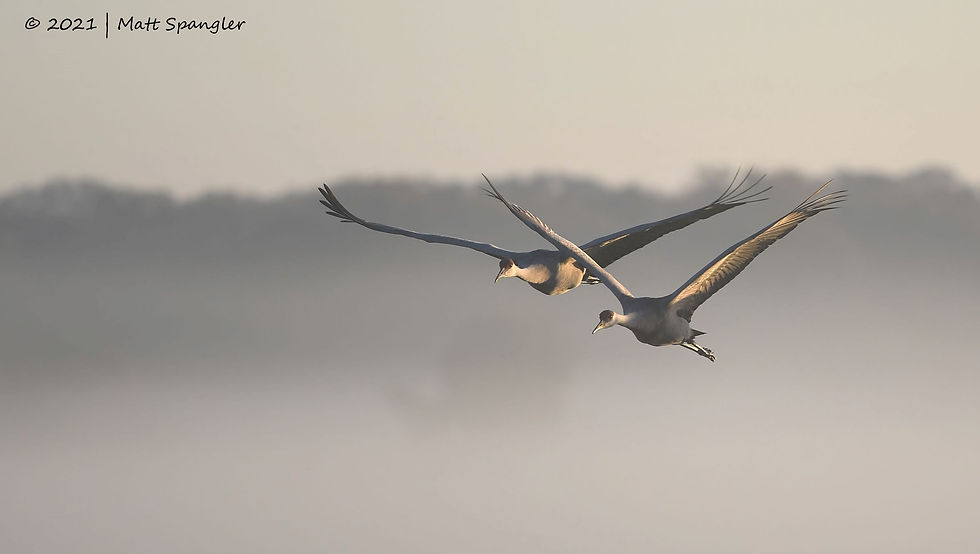
Part 1: Wilmington
Friday
The first part of Christmas vacation (set off from the other two parts by a couple days of work) featured a long weekend in Wilmington, NC. My car was fully loaded with adventure gear: kayaks and bikes strapped to the top and rear. On Friday, my wife and I paddled the marshes around the Fort Fisher Basin and Zeke’s Island. As the tide dropped, we posted up on an exposed sandflat island for a relaxing picnic lunch, complete with pizza, beer, and birds! I saw good numbers of shorebirds and waders (nothing unusual), but the best birds were a couple Seaside Sparrows and a very distant Peregrine Falcon. My wife also pointed out a couple Atlantic Bottlenose Dolphins. After our outdoor adventure, we settled in and enjoyed a nice dinner and a standup comedy show in downtown Wilmington.
Saturday-Sunday
Saturday began with a short bike ride to Greenfield Lake, followed an 4-mile loop on foot. The birding was good; of the 53 species I saw, the most interesting were Wood Ducks, Anhingas, Blue-headed Vireos, a House Wren, an Orange-crowned Warbler, and some Rusty Blackbirds. It was also a lot of fun watching dozens of passerines mob a Barred Owl. Other than birds, the trip wasn’t too remarkable (I couldn’t find any gators), but a new bug landed on my shirt: a native Twice-stabbed Lady Beetle. Later in the day, we passed a flock of White Ibis foraging in a grassy median of our suburban neighborhood. That’s a Florida power move I’ve never seen in NC.
Our friends joined us in the afternoon. This is a nature blog, so I’ll keep this part short. We hung out, hit the town, ate oysters, ate dinner, saw a burlesque show, and visited a piano-less piano bar. Sunday, by consequence, was a slow day. This worked out for the best, as it was cold and rainy (the only bad-weather day of Christmas vacation).
Monday
On Monday, we emerged to explore the world again. The cold, windy world. We first headed to Wrightsville Beach, where I posted up on the pier for some seawatching. Among dozens of Common Loons and a Red-throated Loon, I spotted my target: a Pacific Loon (the first I’d ever seen in NC; state bird #329). Also of interest was a continuing hen Common Eider. After that, I joined my wife for a short walk around the south end of the island, and then we departed.
On our way home, we stopped by Holly Shelter GL for a slightly warmer 14-mile bike ride. While there, we saw a Red-cockaded Woodpecker, and not much else. That’s it for Part 1, the warm-up to our vacation.
Part 2: Palmetto Bluff
Wednesday-Thursday
After working from home for a couple days, my wife and I hopped in the car once again for Part 2 of our Christmas vacation. This time, only bikes adorned the car. On Wednesday, we headed to Greensboro and enjoyed a relatively late night with my parents. On Thursday, we made the 6+ hour traffic-filled drive down I-95 to Palmetto Bluff, SC. Upon arrival, we explored a little and spent a relaxing night with my wife’s family.
Friday
The Palmetto Bluff adventures commenced on Friday (Christmas Eve). The first bird I saw that morning was also the best bird. En route to the kayak outfitter, I checked out the May River, and saw a Long-tailed Duck gobbling down eating oysters! After that, I hopped in a kayak and paddled about 6 miles around the extensive freshwater lagoons. The (second) best birds were Wood Storks, and the most numerous were Yellow-rumped Warblers—I counted at least 165 so-called “Myrtle Warblers” in the Wax Myrtles lining the lagoons. I also saw two American Alligators and many Yellow-bellied Sliders in the lagoons.
After kayaking, my wife and I biked some of the neighborhood trails. The wildlife highlight was a relatively tame Southern Fox Squirrel. These gigantic, handsome rodents were common throughout the property, but really exciting to see.
After lunch, we biked another 11 miles to the south end of the development, canvassing a variety of habitats, including freshwater lagoon, brackish river and marsh, live oak forest, longleaf pine forest, and, of course, neighborhoods and retail developments. We didn’t see any fox squirrels on this leg, but we did see a group of 25 Wood Storks, probably the most I’ve ever seen together. As you can tell, most of my photos from Palmetto Bluff feature ether Fox Squirrels or Wood Storks.
We spent sunset fighting gnats on the lagoon while watching a procession of birds fly in to roost on “Bird Island.” Hundreds of Double-crested Cormorants were joined by dozens of wading birds (six different species). Their (mostly) white forms spangled the trees, silhouetted against the darkening sky. It’s always fun to see large numbers of birds congregate. We eventually retreated indoors to a nice dinner at the hotel, followed by more family time.
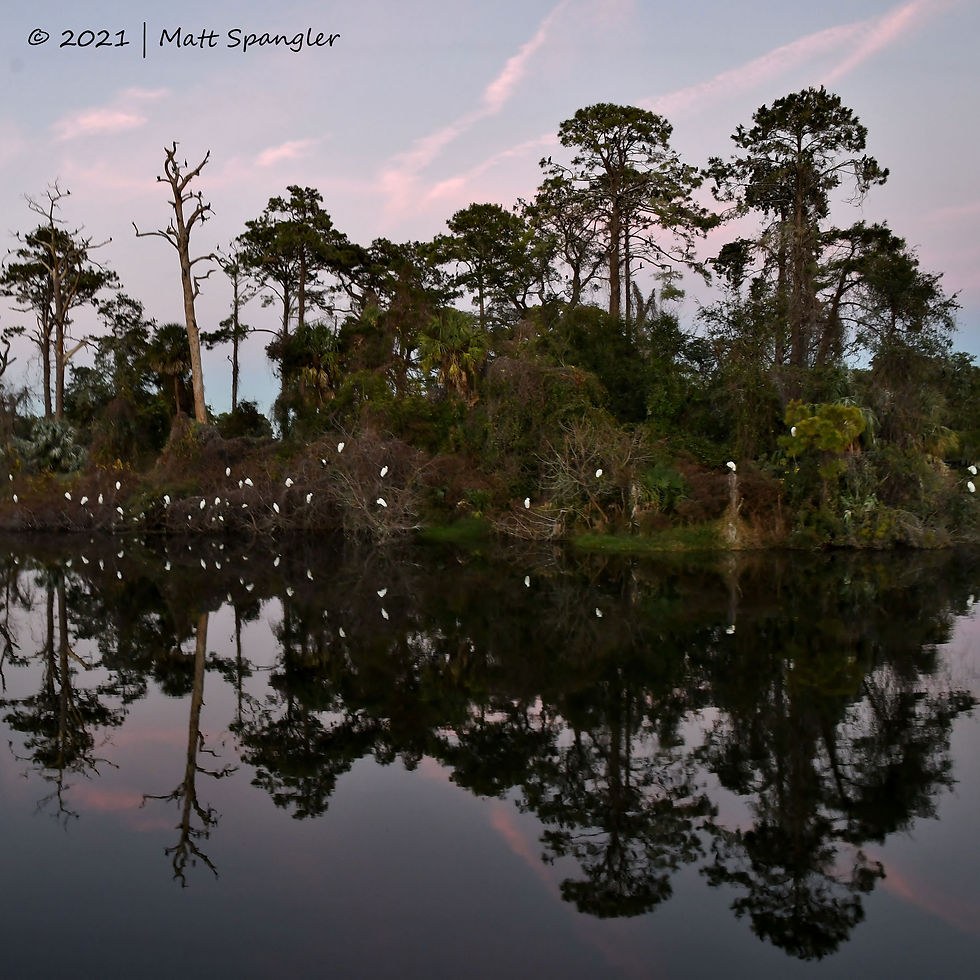
Saturday
We enjoyed a relaxing Christmas morning with the fam. After that, my wife, her brother, and I headed out for another paddle trip, this time up the May River. It was gloriously warm and sunny. Although I usually prefer paddling a falling tide (which exposes more bird habitat), the high tide allowed us to bushwhack through the submerged marsh vegetation and eventually land on an a 1.5-acre island. I’m not sure if this island (and others like it) were naturally formed, or the spoils of dredging the river. But in any case, the island was a microcosm of archetypal lowcountry vegetation—including Live Oak, pine (not sure what species), Cabbage Palmetto, Saw Palmetto, Wax Myrtles, Atlantic Redcedar, and many others plants I’m less familiar with. A big Sheepshead that passed under my boat was a new fish for me. Otherwise, the wildlife was standard fare, with a few ducks and shorebirds, a Bald Eagle, etc.
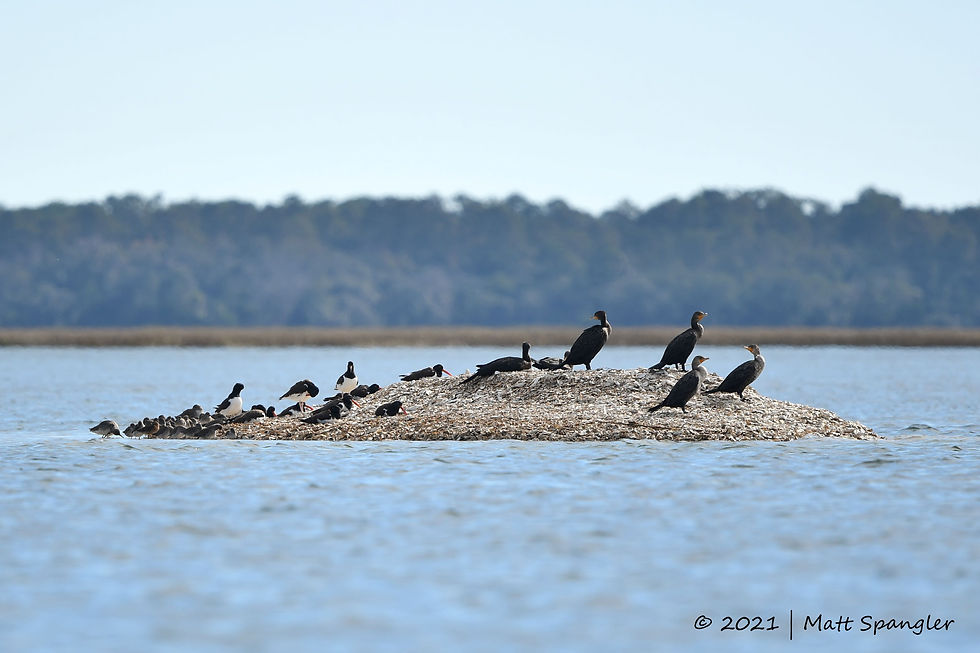
Walking around the village after lunch yielded 3 more Fox Squirrels; two were gray with black faces, and one was solid black with a white face.
I spent the evening fighting gnats (again), this time on the May River. The expansive marsh glowed in the sunset and teemed with a mixture of foraging ducks, shorebirds, waders, grebes, and loons. After dark, I rejoined the family and enjoyed an excellent dinner at the Canoe Club before bidding everyone farewell.
Part 3: Florida
After South Carolina, I parted ways with my wife and headed to Florida for the third and final segment of the vacation. I broke the Florida trip into two segments: first, camping near Gainesville and birding around Paynes Prairie SP; second, hanging out with my family and birding around Dunedin. As with many solo trips, I spent a lot of time birding and photographing wildlife, so this will be a lengthy blog segment.
Sunday
I hit the road early Sunday morning, hoping to spend more of the day birding than driving. However, not too long after departing, I realized my binoculars were nowhere to be found, so I had to turn around and reclaim them from under a bush at the Palmetto Bluff rental house. I suppose the delay was better than buying a new pair of bins….
Eventually, after about 5 hours of driving, I arrived at my campsite and home base for the next couple days. It was a nice 6-acre property backing up to thousands of acres of Paynes Prairie SP; it featured a house, a few (unoccupied) campsites, a clearing, a small garden, some domestic chickens and ducks, lots of forest, and a creek. This Hipcamp was way better than any commercial campsite (Hipcamp is to campsites as airBnB is to hotels). It was in Florida, so there were many lizards, including a bunch of invasive Brown Anoles (aka Cuban Anoles) and a sole Green Anole. The invertebrates were even more interesting. I repeatedly flushed at least two Twilight Darners from young Cabbage Palms, but could never manage a photo of one of these secretive dragonflies. I also saw 8 species of butterflies, including a Zebra Longwing, a Tropical Checkered-Skipper, and a Little Yellow. I’m still working on my ID skills for Orthoptera (grasshoppers, etc.) and Arachnida (spiders, etc.), but I managed to ID one Obscure Bird Grasshopper and one Mabel Orchard Orbweaver (the latter spider was new for me).
After the campsite, I began my birding journey with a quick stop at Newnans Lake, mainly because it was very close to the campsite. The birdlife was unremarkable (save for a large gathering of Bald Eagles), but a Twin-spot Skipper made the short excursion worthwhile.
I spent most of the afternoon at Sweetwater Wetlands Park, a well-managed 125-acre water treatment wetland bordering the northern edge of Paynes Prairie SP. The birding was great. Of the 11 species of waders present, I particularly enjoyed photographing Wood Storks (surprise!), and also saw Roseate Spoonbills, Glossy Ibises, a Black-crowned Night Heron, and some Cattle Egrets. A lone Purple Gallinule and a Spotted Sandpiper were perhaps the least common birds seen.
Sweetwater was a great place for invertebrates, too. I saw a handful of Red Saddlebags (lifer dragonflies), Florida Bluets, and Roseate Skimmers, plus a few other less interesting odes. Of the 6 butterfly species present, Ceraunus Blue and White Peacock were the most interesting. And, of course (back to the vertebrates), there were American Alligators; I saw 7, including a few big ones. Florida Red-bellied Cooters were another good herp.
As the afternoon wore on, I headed to downtown Gainesville. I had an hour to kill before a sunset appointment at the University of Florida. It took about 20 minutes of desperate searching to find an open bar or restaurant (it was winter break), but the cold beer was worth the wait. After that, I headed to UF and posted up near some chimneys that have reliably hosted a group of Vaux’s Swifts in recent winters. This western species is rare on the east coast, so it was a treat to see them at a dependable location. Bird lifer #1 for the trip!
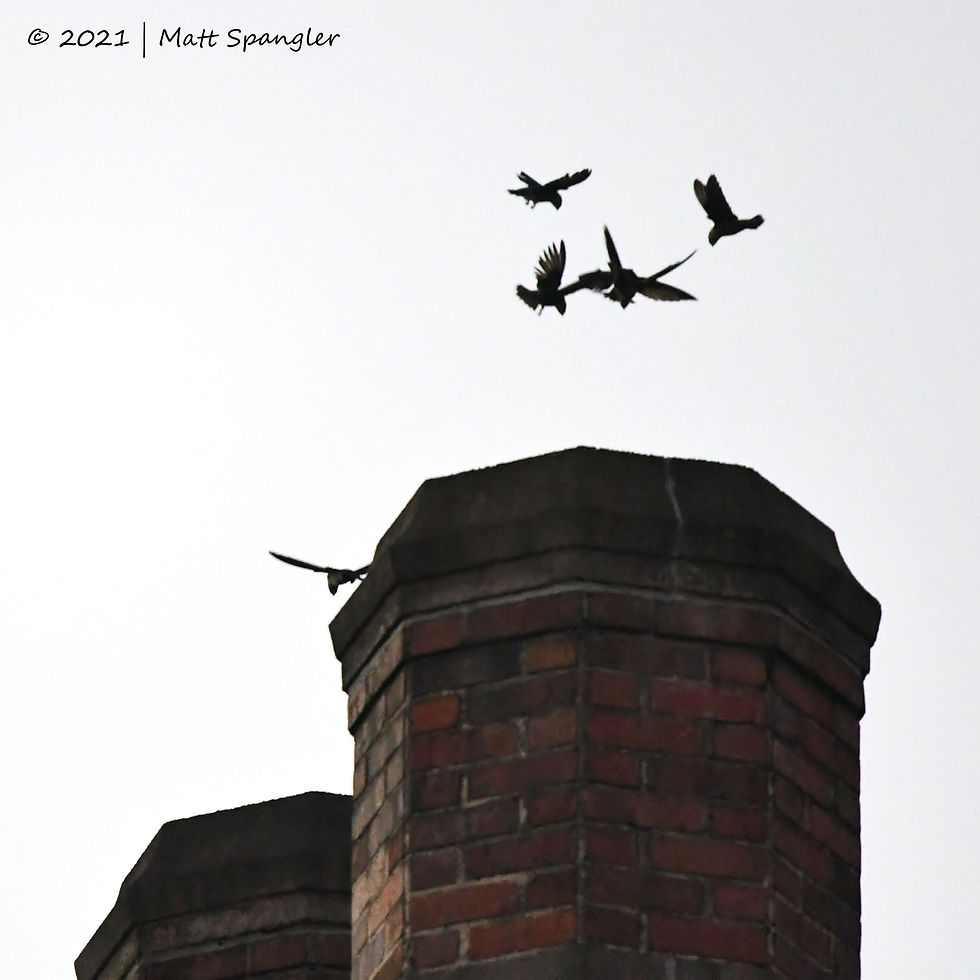
After a fulfilling day, I returned to my Hipcamp for a low-key night. If I had to pick a favorite interruption to my sleep, it was a pair of Barred Owls. Despite the many charms of the campsite, there was a lot of road noise and a rooster whose internal clock could use some adjusting.
Monday
On Monday, I committed myself to a full day of birding. So, naturally, I woke up early and tried to get out before sunrise for some owling. This plan was stymied by well-locked gates and a general lack of public parking around the northeastern side of Paynes Prairie; I ended up parking at a church a few miles away and biking to my first destination.
By the time I got to the La Chua trail—a boardwalk and trail around the Alachua sink—it was still moderately dark and extremely foggy. The only reward of my early morning adventure was a pair of Great Horned Owls countersigning in a towering Live Oak (which was, ironically, quite dead and draped with Spanish Moss). The persistent low-lying clouds lent an enchanting air to the wetlands on the periphery of the prairie, but they also made wildlife photography difficult. The prairie was also completely flooded; almost none of the trail into the prairie was accessible. Those two complaints aside, the birding at this location was incredible. I’d go so far as to say it’s one of my favorite places in Florida to bird. It’s on my top 10 list, at least.
The unquestionable highlight was a constant procession of Snail Kites casually picking snails from the water’s surface, at times less than 20 feet away. I can’t imagine ever being so close to so many of these unique, endangered raptors. They only eat snails. And their recovery is, ironically, succeeding due to the increased prevalence of an exotic snail species that has invaded Florida wetlands.
The La Chua boardwalk hosted many other interesting birds, including hundreds of Black-bellied Whistling-Ducks, many Limpkins (whose raucous calls eventually bordered on annoying), various wading birds (including some Glossy Ibises and a flyover Roseate Spoonbill), and some Wilson’s Snipe. As the fog showed no sign of lifting, I eventually left the wetlands and hiked through some partially-flooded trails in search of landbirds. Highlights included 7 species of warblers. A group of Marsh Rabbits, some White-tailed Deer, a Green Treefrog, and some heard-only Spring Peepers were the primary nonavian attractions of the early morning.
After my hike, I biked a couple miles to a bluff overlooking the prairie. I looked, but I could not see anything, owing to the fog. All was not lost; on the trail in, I saw a group of Wild Turkeys and some interesting passerines (including a second Ovenbird and some White-throated Sparrows, relatively uncommon in Florida).
In addition to wildlife, biking the area afforded a nice perspective on the area’s karst topography. Like much of Florida, this area is predominantly limestone, punctuated by a number of impressive 50-100 foot deep sinkholes, between which the bike trail weaved. The fully inundated Alachua sink (aka the La Chua trailhead, the focal point of bird activity) actually extends down to the Floridan aquifer and is apparently popular with cave divers.
As the morning wore on, I couldn’t resist the temptation to get back to the sink in hopes that the fog would lift and I could get some better photos of kites. Hours of waiting finally paid off when the fog finally lifted around 10:40 AM. I captured some of the 11+ (!) Snail Kites foraging in the area, as well as some good portraits of a friendly Limpkin hanging out on the boardwalk. Otherwise, the birdlife was essentially the same as earlier in the morning, with the addition of some flyover Sandhill Cranes.
The sun also brought out several Alligators and a Green Anole.
After spending basically half the day in the same (great) spot, I opted for a change of scenery in the afternoon. I headed out of town to the western edge of Alachua County. There are a lot of cattle farms in this part of Florida, and it was cool to see scores of Sandhill Cranes and a dozen Cattle Egrets mingling with the cattle. By the time I got to the Watermelon Pond WEA, it was hot and sunny. It reminded me of the NC sandhills with a western cattle ranch thrown in. It was raw, rugged, and wild; a nice mix of prairie, shallow wetland, and sandy pine forests. Perhaps more importantly, it was largely human-free, unlike Sweetwater and the La Chua trail.
I traversed the sandy trails by bike. It was more exploration and exercise than birding, but I still managed to see some interesting grassland species, Sandhill Cranes, Northern Harriers, American Kestrels, Loggerhead Shrikes, Eastern Meadowlarks, and a Field Sparrow. Interestingly, the yellow (eastern) Palm Warblers almost outnumbered the brown (Western) subspecies here; both were extremely abundant. I also saw a couple Muscovy Ducks, which count as wild birds in Florida. Birds are cool, but my favorite wildlife sightings were two Gopher Tortoises and a Florida Soft-shelled Turtle. I also saw some Southern Cricket Frogs, Roseate Skimmers, a little Blue Dragonlet, among others.
After Watermelon Pond, I headed back to Paynes Prairie, this time to the trails at Bolen Bluff (west side of the prairie). The trail was a bit too long through the forest and a bit too short through the prairie, which was just as flooded as La Chua. I didn’t see many birds, but I did see 3 American Bison standing defiantly in the knee-deep trail, just in front of the viewing platform that was out of reach. After spending a couple days around the (mostly) natural prairies at Paynes Prairie and Watermelon Pond, I can better imagine how these stolid beasts once roamed this area. Bison were reintroduced to the prairie in 1975 after white settlers extirpated them hundreds of years ago.
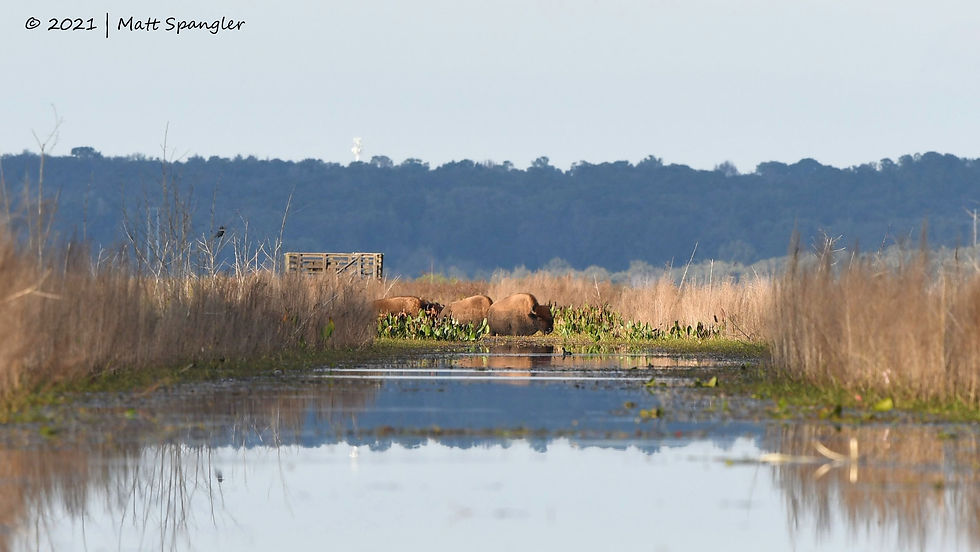
I returned early to the campsite for an early night, lit a fire (which did nothing to prevent 20+ mosquito bites on each ankle), and retired for a great night’s sleep.
Tuesday
I awoke at dawn to the sound of Black-bellied Whistling Ducks overhead. After packing up camp, I made one last visit to Paynes Prairie, checking out the visitor center on the southwest side of the prairie. The 50-foot observation tower provided spectacular views of the landscape. I then hiked Cone’s Dike trail, and made it almost a mile before the prairie opened up and … the trail was flooded. I’ll have to return sometime when the water levels are lower. Highlights included a Cattle Egret riding a feral horse (whose ancestors arrived with the Spanish), another bison, lots of deer, and a gator. The best birds were a big flock of 115 Northern Pintails and a group of American White Pelicans kittling with some vultures.
By mid-morning, I departed Gainesville and headed south towards my family, with two stops on the way. First up: Three Sisters Springs at Crystal River NWR. Mammals were the primary attraction. I saw 19 West Indian Manatees loafing in the crystal-clear springs (the manatees were outnumbered only by humans). Odonates were secondary. Of 9 species present, Scarlet Skimmer was a lifer, as was a possible Phantom Darner (I’m not 100% sure on its ID). I was also able to get some good photos of a male Roseate Skimmer in a flooded roadside ditch. Third: the leps. Of 10 species present, Barred Yellow was a lifer, and Ceraunus Blue, Orange-barred Sulfur, Zebra Longwing, and Dorantes Longtail were all notable to a North Carolinian like myself. Birds were fourth on the priority list (for once). I spent some time with an extremely cooperative Wilson’s Snipe hanging out in the dragonfly ditch, and also watched two Red-shouldered Hawks procreating. Last but not least, there were a handful of herps present; the most interesting were a couple Suwanee Cooters, and what I think is a hybrid between a Yellow-bellied and Red-eared Slider.
My second stop of the afternoon was the Citrus Tract of the Withlacoochee SF. PSA: don’t let Google Maps convince you to enter from the west unless you have a Jeep! My sedan barely made it through the highly eroded roadbeds, but I’ll admit it was pretty exciting (“harrowing” is probably a better word). Once I landed on firmer roads within the forest, I hopped on my bike for another day’s exercise. I pedaled roads and trails through some nice tracts of Longleaf Pine and was rewarded with a couple sightings of Red-cockaded Woodpeckers and a Hairy Woodpecker. I also saw a Southern Dogface (lifer butterfly) and dozens of Ornate Bella Moths.
That was it for the day’s nature adventures. I eventually made it to Dunedin and enjoyed a big Christmas dinner with two uncles, an aunt, and my Grandma, before retiring at my uncle’s house.
Wednesday
Wednesday, like many of my vacation days, began unreasonably early. Sometimes, it’s worth it; sometimes, it’s not. This time, my 90-minute predawn drive south to the Myakka River wasn’t entirely worth it. I arrived before sunrise, but the dense fog (sound familiar?) prevented me from finding my target: a recently reported Whooping Crane. The cranes spend the night but leave around dawn, so waiting for the fog to lift wasn’t really an option. Another downside was the location itself; the only vantage point was from the middle of a relatively well-trafficked bridge. Fog and car complaints aside, it was nonetheless a beautiful morning. It’s always nice to see Mottled Ducks, Sandhill Cranes, Wood Storks, American White Pelicans, 7 species of herons and egrets, a Roseate Spoonbill, hundreds of White Ibis and a dozen Glossy Ibis, etc.

Next on my birding journey was the Sarasota “Celery Fields.” I spent an hour or so hanging out at the bird feeders, hoping for another target. As is often the case when chasing rare birds, I struck out on the Bronzed Cowbirds seen recently. However, I saw a ton of other good birds, including dozens of Nanday Parakeets, a Yellow-headed Blackbird, an Ovenbird, and a gorgeous male Painted Bunting. The icing on the cake was a Hyacinth Glider patrolling overhead (lifer dragonfly), plus a handful of butterflies and a Marsh Rabbit.
I headed back north to Fort De Soto, where I spent the afternoon biking about 14 miles and hiking the north end of the beach. As always, the birding was great—especially the shorebirds. Of the 15 species present, most notable were 7 Snowy Plovers, 6 Wilsons’s Plovers, a whopping 23 Piping Plovers, an apparently injured American Golden-Plover, many Marbled Godwits, some Red Knots, and other more common species.
Also interesting were Reddish Egrets, Nanday Parakeets, an American Kestrel, a Loggerhead Shrike, many Black Skimmers, roughly 130 American White Pelicans, and a pair of Magnificent Frigatebirds that hovered so still I thought they were kites!
Beyond birds, I saw 9 species of butterflies, including two lifers: a Cassius Blue and a Mangrove Buckeye (found alongside some Common Buckeyes), plus many other southern specialties seen earlier on the trip. I also saw a couple Atlantic Bottlenose Dolphins out in the surf.
As the afternoon wore on, I had to make a difficult decision: head back home (according to my initial plan), or drive back south to make one more try for the Whooper. I went with the latter and joined a group of birders back on the Myakka River bridge. After much waiting (and many cars driving by), the lone Whooping Crane arrived with a group of Sandhills around 5:50 PM. Lifer bird #2 for the trip, and well worth the second attempt. This bird is one of a small population of nonmigratory Whoopers released in central Florida in the ‘90s as part of a now-abandoned reintroduction effort. Apparently FWS is planning to translocate those cranes to Louisiana to see if they fare better. In addition to the Whooper, at least 180 Sandhill Cranes were also present; they’re doing much better than their endangered cousins. Many of the morning’s bird were also present, joined by a Merlin, a Long-billed Dowitcher, and a Limpkin.
That was my last long day of dedicated birding. After a long, dark drive back to Dunedin, I spent another nice night with the fam.
Thursday
I enjoyed a slower start on my last full day of the trip, hanging out with my uncle in the morning. Eventually, I hopped in his kayak and paddled across the St. Joseph Sound towards Caladesi Island SP. I started at the south end of the island, entering a dense forest of Red Mangroves, through which a number of trails (really, tunnels) run. It’s a unique, almost otherworldly paddling experience. Very quiet, but very alive. I saw at least 600 Mangrove Tree Crabs scurrying up the exposed mangrove roots, a few Mangrove Periwinkles affixed to same, and a cryptic Twilight Darner hiding within the dense foliage. There weren’t many birds in this section, but I did see a Sharp-shinned Hawk and an immature Night-Heron.
I eventually emerged from the mangroves. The open water of the bay held some ducks and an extremely photogenic Horned Grebe. Highlights of the sky included a Magnificent Frigatebird and 16 Osprey kettling like vultures (something I’ve never seen before). I also saw a Bottlenose Dolphin, a dozen Sheepshead, and some Jumping Mullet in the bay (Mullet jumping in the bay?).
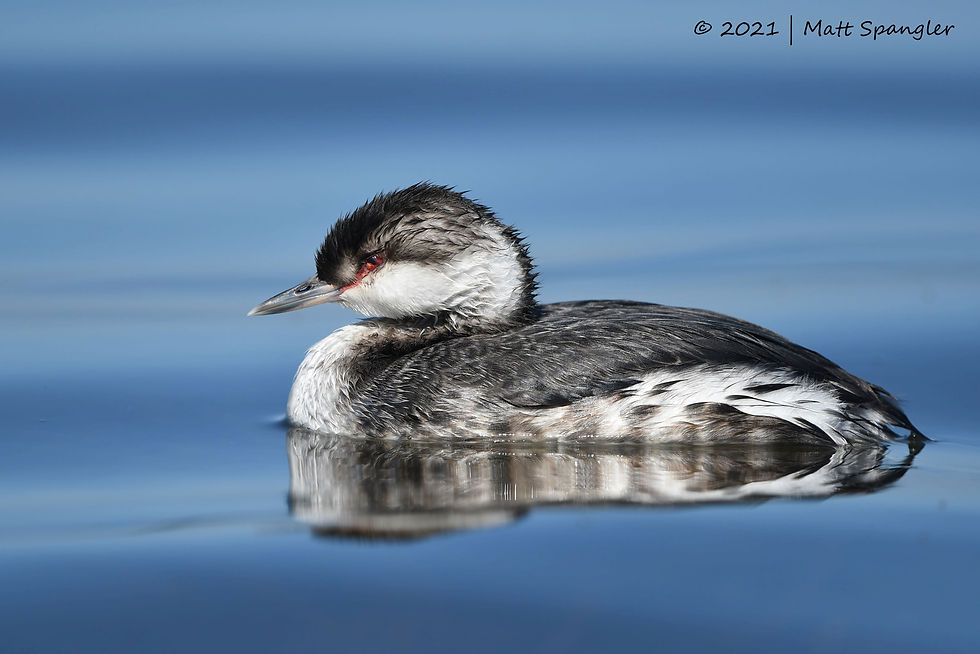
As the tide began to fall, I posted up at the extensive sandflats the north end of Caladesi. The timing was perfect, as shorebirds were just arriving. Of 14 species present, a Wison’s Plover, a Piping Plover, a Greater Yellowlegs, and a large group of Marbled Godwits were probably the most interesting. A variety of waders were also present, including a Reddish Egret. There just isn’t much better than sitting in a kayak on a sunny day, surrounded by wildlife.
I eventually headed back across the bay towards my uncle’s house. The 3-mile return featured a headwind and choppy waters. It was exhausting, but it made for a satisfying end to a full day on the water. I headed over to my Grandma’s for some more family time, followed by a night out in Dunedin with my uncle, and that was the end of my stay on the gulf coast.
Friday
I awoke early on Friday morning (New Years Eve) and prepared for a long drive back to North Carolina. But not before one last birding trip! I added a half hour to my total drive with a stop at Newton Park on the south shore of Lake Apopka. This is the #1 place to get up close and personal with Purple Gallinules. I counted 32 on this trip, but many more were undoubtedly hiding in the vegetation. They’re everywhere; some even came within arm’s reach on the sidewalk and boardwalk.
Many other good birds were present, including a couple Black-bellied Whistling-Ducks, a Limpkin, lots of wading birds, etc. But the real prize was a duo of Bronzed Cowbirds—lifer #3, and, apart from the gallinules, a big reason I chose Newton Park for my last stop of the trip. This species regularly visits this park in the winter, but that doesn’t mean they’re always easy to find (I missed them on multiple attempts last year). After getting a few good photos of the cowbirds, I hopped in the car, content to head home.
I drove straight home from Lake Apopka, stopping twice for gas and making it back in about 9 hours (plus 2 hours earlier in the morning). I’ve never made such a long drive before, but it was good to know this is a realistic option (with enough coffee and a good audiobook). After all, it was New Years Eve, and I wanted to get back to my wife (and cat)!
Summary by the Numbers
This was a long, 3-part trip. I (or we) traveled roughly 2300 miles by car, 60 by bike, 24 on foot, and 23 by kayak. As you probably noticed, I took a lot of photos—1861 with my camera, plus many on my iPhone that were irretrievably lost.
I saw 160 different species of birds. Not bad for December! 3 were lifers (Vaux’s Swift, Whooping Crane, Bronzed Cowbird), bringing my life list to 453 species. 23 were new for 2021, bringing me to 289 for the year. Of the 87 species I saw in NC, I got 1 new state bird (Pacific Loon), bringing my total to 329. Of the 63 species in SC, 4 were new, bring me to 194. Of the 141 species I saw in FL, 14 were new, bringing me to 203.
Nonavian wildlife was also exciting. I saw 14 species of odes (dragonflies/damselflies); 3 or 4 were new (Red Saddlebags, Scarlet Skimmer, Hyacinth Glider, and a possible Phantom Darner), bringing my life list to 126 or 127. Of the 22 species of leps (butterflies), 4 were new (Barred Yellow, Southern Dogface, Cassius Blue, Mangrove Skipper), bringing my life list to an even 100. I saw 13 species of herps (reptiles/amphibians); none were new, but Gopher Tortoise and Florida Softshell Turtle were a nice treat. Last but not least, in addition to homo sapiens, I saw 12 species of mammals; none were new, but Manatee, Bison, Fox Squirrel, and Armadillo were the coolest. That’s all I’ll quantify for now! Until next year….
































































































































































































































































































































